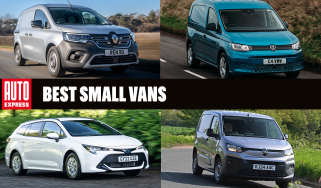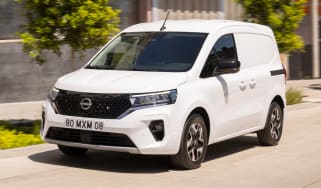Nissan Townstar van review
The Nissan Townstar looks to the future of the small van sector with a raft of tech features
Our opinion on the Nissan Townstar
The Nissan Townstar is a strong contender in the small van segment and the brand’s focus on the electric version makes sense. The 178-mile range of the Townstar EV is competitive and while it doesn’t redefine the laws of physics with its performance, the compact electric van is relatively comfortable, practical and has some high-end tech features, if you’re prepared to pay for them. If your business is auditioning for an urban runabout or last-mile delivery vehicle, this Nissan could play a starring role.
About the Nissan Townstar
The Nissan Navara pick-up truck might not be on sale in the UK any more, but the Japanese brand does offer a full range of panel vans. The Townstar is the smallest of the bunch, serving as Nissan’s entry in the compact van, or small van segment, and sits below the medium sized Primastar and the Interstar large panel van.
The days when diesel dominated the van market are over and Nissan has been at the forefront of the switch towards electric power since it introduced the e-NV200, which claimed 63 per cent of the UK’s electric van market between 2019 and 2020. Now the Nissan Townstar continues where the e-NV200 left off, and is only offered in petrol or pure-electric forms – with the EV expected to take the majority of sales.
Used - available now

2025 Toyota
Yaris Cross
15,410 milesAutomaticPetrol1.5L
Cash £19,993
2024 Toyota
Aygo X
11,073 milesManualPetrol1.0L
Cash £12,986
2018 Toyota
Prius
55,915 milesAutomaticPetrol1.8L
Cash £14,586
2024 Toyota
Aygo X
30,682 milesAutomaticPetrol1.0L
Cash £12,956In addition to the choice of a 1.3-litre petrol engine with 129bhp or the Townstar EV with 121bhp and a 45kWh battery, there are also two body lengths available, L1 and L2. The latter adds an extra 426mm to the length of the van and an extra cubic metre of carrying capacity, creating a choice of 3.3 or 4.3 cubic metres load volume for customers. Payloads are determined by powertrain choice as well as wheelbase so the petrol models can carry 840kg (L1) or 846kg (L2), while the electric versions are rated at 612kg (L1) or 788kg (L2).
The Townstar L2 is also available in Crew Van configuration meaning it has seating for five people. There’s 2.1 cubic metres of space on offer with the rear seats in place, expandable to 3.1 cubic metres if you fold them down, but you can only get the Crew Van as an EV.
Platform sharing is an important thing to get your head around when buying a van. The cost of developing a brand new vehicle from scratch and the simple, utility-focused design of light commercial vehicles leads manufacturers to club together and share the load.
It means that buyers are often confronted with various versions of what is ostensibly the same van, wearing different badges. The Nissan Townstar, for example, uses the same platform as the our Van of the Year for 2023, the Renault Kangoo, and the Mercedes Citan – or the Kangoo E-Tech and eCitan if you’re talking about their respective electric versions.
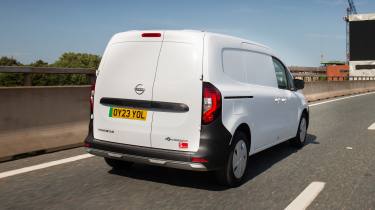
The Townstar has a lot more in common with the Kangoo than its platform though, as the Nissan features the same infotainment system as the Renault, plus their cabins are nearly identical. Meanwhile, Mercedes has tweaked the Citan’s interior slightly and added its own MBUX infotainment setup.
Today’s van buyer has lots of choice, but when you’ve narrowed the search down to versions of the same vehicle from different brands, the final decision may come down to matters of price, equipment and the quality or even the location of your local dealer.
Nevertheless, the Nissan Townstar currently starts from just over £22,000 in petrol form while the entry-level Townstar EV is priced at around £32,000 after you factor in the £2,500 Plug-in Van Grant (PiVG). It’s a price differential that is fairly standard in today’s van market, but even so the Townstar EV is still £10,000 more expensive to buy than its petrol-powered equivalent.
That’s a high price gap to overlook, so operators need to carefully weigh-up the potential savings associated with running the EV version. With the right usage patterns though, in urban locations (especially those with low emissions zones) an electric van can be very cost effective over the long term.
Range, charging & running costs
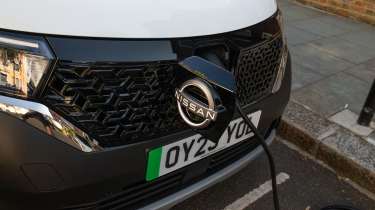
Pros |
Cons |
|
|
There’s no diesel option in the Nissan Townstar lineup and that’s still a relatively novel approach, even in a small van market where diesel is very much losing its former dominance.
Nissan, of course, will tell you that an oil-burner isn’t necessary when the 1.3-litre petrol can return around 39-41mpg on the WLTP combined cycle. CO2 emissions stand at roughly 155-160g/km, with the L2 version marginally less efficient than the L1. Heads could be turned by the Townstar’s Renault Kangoo sister van though, as it’s still available with a diesel engine that’ll return 53mpg according to the French firm.
The Townstar EV is powered by a 45kWh lithium-ion battery and has an impressive WLTP combined range of around 178 miles. If you only drive in town, in optimum conditions (i.e. low load and warm weather), Nissan claims the electric Townstar will manage up to 206 miles.
We drove the Townstar EV on a mixture of UK roads during our testing and covered around 150 miles in total. Over that time we managed to achieve 3.1 miles per kWh, which equates to a real-world range of 139 miles.
The Townstar boasts 22kW AC charging which means you can fully replenish the Townstar’s battery from 15-80 per cent in 1.5 hours using a suitable home wallbox. Its 80kW DC charging ability provides the same top-up in just 37 minutes.
All models come with two charging cables, one for a domestic plug socket, and the other a type 2 cable for home wallboxes or public charging points.
Load space and practicality
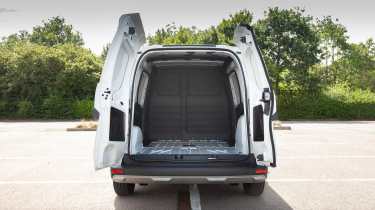
Pros |
Cons |
|
|
Whether you choose petrol or electric power for your Nissan Townstar, there’s no difference in the size of the load area. The L1 model can carry 3.3 cubic metres of cargo, while the L2 will squeeze 4.3 cubic metres inside. The load lengths are 1,806mm and 2,230mm for the L1 and L2, respectively.
Even the L1 can take a pair of Europallets and comes with a single nearside sliding side door fitted as standard on base model, though Acenta trim and above adds a second off-side sliding door. On the L2 models, the twin sliding side doors are actually wider, growing from 615mm to 831mm, and you can load a Europallet through them. The rear doors can open up to 180 degrees, and you can add accessories like a roof rack, fixed towbar and wooden load space protection should you wish.
There is a difference in payload capacity because, while the L1 petrol model has a circa-1,500kg kerb weight, the Townstar EV’s battery takes it to over 1,700kg. As a result, the petrol Townstar’s maximum payloads are 738kg for the L1 and 767kg for the L2, however the EV only manages 502kg and 713kg respectively. Both models can tow a 1,500kg braked trailer.
As we mentioned, the Townstar EV is also available in Crew Van configuration with seating for five. As it’s on the L2 body length, the Townstar Crew Van benefits from the wider sliding doors, making access into the rear easier. There’s also 2.1 cubic metres of cargo space with all five seats in place, or 3.1 cubic metres with just the front two seats left up. Unsurprisingly, due to the extra seating the Crew Van weighs in at nearly 2,000kg, so its maximum payload is reduced to 734kg (petrol) or 692kg (EV). The EV model is also not rated for towing.
All models get a plastic bulkhead separating the cabin from the load area, but like its Kangoo and Citan sister vans, the Townstar’s bulkhead is curved. This is likely to help create a more comfortable car-like driving position, but it also eats into the cargo space somewhat. There’s no load-through option to poke longer items through into the cabin either, because the clever hinged bulkhead isn’t being made available in right-hand drive models.
Reliability, safety and security
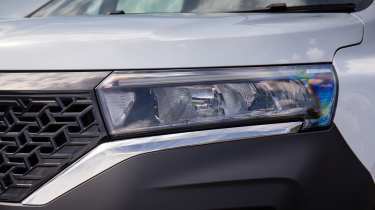
Pros |
Cons |
|
|
As is so often the case in commercial vehicles, the entry-level specification isn’t overflowing with safety kit. Although no longer available on the latest price list, the Townstar Visia model includes a driver’s airbag, tyre pressure monitoring, hill hold assist, a full-width bulkhead and load-lashing points in the rear.
The top-of-the-range Tekna+ has also been discontinued, leaving the Acenta and Tekna specifications to choose from. The former includes LED headlights, rear parking sensors, and cruise control, while upgrading to Tekna brings front, rear and side parking sensors, keyless entry and go, a smartphone holder and integrated navigation.
All Nissan Townstar models get a five-year/100,000-mile warranty, and there’s eight years of cover for the battery in the Townstar EV with the same 100,000-mile limit.
Driving and performance

Pros |
Cons |
|
|
With no diesel Townstar, Nissan envisages the Townstar EV being the big seller, ably supported by the cheaper petrol option for drivers who cover longer distances.
The petrol is a 1.3-litre four-cylinder unit that produces 129bhp and 240Nm of torque at 1,600rpm. It’s mated to a standard six-speed manual gearbox and can hit a top speed of 114mph (not that it matters to UK drivers much). Meanwhile, the Townstar EV uses a single electric motor producing 121bhp and 245Nm, all of which is sent to the front wheels.
The standard ‘D’ drive mode allows the Townstar EV to coast like a regular automatic, while there are three settings for the regenerative braking system that lets you slow down by lifting off the throttle. Unfortunately, even the highest ‘B3’ setting isn’t particularly strong in its braking effect, so it’s not capable of one-pedal driving – a feature that would have been great to have in an electric vehicle that’s expected to spend most of its life in stop-start city traffic. We also wish the Townstar featured brake auto-hold for the same reason.
The Nissan Townstar feels like a very competent customer on the road. On UK roads, we found the ride was on the firm side of comfortable, but well damped enough to take the edge off the bumps. It never felt harsh or rattly, even over recently resurfaced roads and severe speed humps with no load in the back.
With reach and rake adjustment on the steering column, finding a very comfortable driving position for anyone around six-feet tall is a cinch, as we found out first hand. That’s with the driver’s seat at the very back of its available travel though, so very tall drivers could find the space a little more cramped.
Outside, Nissan has given the van ‘Canto’: the specially developed sound effect that features on its electric passenger cars. It’s a gentle note designed to warn pedestrians at low speeds that pulses more loudly when the Townstar is reversing.
The top-of-the-range Townstar EV we drove featured a hands-free parking system, which is very impressive to see on a compact van like this. Once we got the hang of it, the setup worked quite well and provided clear instructions for when you need to switch from reverse to drive, and vice versa. We wouldn’t say it’s worth updating to the top-spec trim for it, as we expect most people would only use it for the trickiest of parking spots, rather than relying on it every day. Our test van also featured a 360-degree camera view, but the poor quality of the cameras meant you couldn’t see that much of what was around you. The reversing camera is equally poor.
Town driving, visibility and parking
As you’d expect for an electric van, the Townstar EV steps off the line very smoothly and it only occasionally struggles for traction, spinning a wheel if you’re over-zealous with the accelerator, such is the low-end torque on offer. The Townstar is happiest when driving in urban areas, with the motor providing adequate performance for zipping around town.
As you’d imagine, progress in the Townstar EV is very quiet. A fair amount of wind nose permeates the cabin at higher speeds and we noticed a slight pitch whine from the electric motor under hard acceleration, but you tend to be more aware of smaller noises like these in electric vans as there’s no lubbering diesel or coarse petrol engine pulling your focus.
Motorway driving and long-distance comfort
The Townstar EV doesn’t struggle to keep pace with traffic on the motorway. Swift bursts of acceleration, say from 40-50mph, feel effortless, however performance tails off quickly after that. 0-62mph takes 11.6 seconds in the L1 or 12.3 seconds in the heavier L2 and it feels it. Eco mode dulls the accelerator response slightly and makes other changes to try and conserve the battery’s charge.
Firm suspension also helps keep the vehicle’s weight in check. There isn’t much body roll and sharp corners can be swept through without fuss. The small, thick-rimmed steering wheel feels good in the hands but the steering itself is quite light and vague. The seats are particularly good, soft enough and supportive.
Cab interior and technology
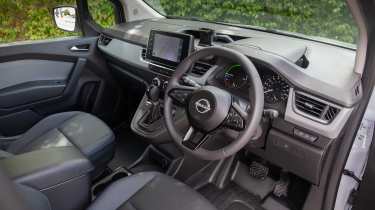
Pros |
Cons |
|
|
The Nissan Townstar’s cabin is built using lots of robust plastics, so it’s not luxurious by any means. But it feels like it can handle life as a workhorse, and includes a few contrasting elements to raise the tone slightly.
Van drivers need plenty of interior storage options to avoid cluttering up the cab, and the Townstar definitely has some interesting solutions in this regard. There’s a deep glovebox, a recessed tray on the dashboard and a small cubby ahead of the driver with charging ports inside. The latter space is a good option for charging a phone and keeping it out of the driver’s line of sight to avoid any temptation, although Tekna models have a dedicated smartphone holder for hands-free navigation or making calls.
There’s another slot below the climate controls for your wallet, plus a tray and two cup holders further down. The door bins are relatively slim, but they’ll hold smaller water bottles and other odds and ends with ease. You also get a larger storage bin under the central armrest, however the armrest doesn’t support itself and is quite heavy, so you need to use one hand to keep it up open, otherwise it’ll chomp down on your wrist.
There's an enormous storage tray above your head too, which we found was large enough to keep the Townstar EV’s charging cables out of sight, but we don’t recommend stowing smaller items up there as it's a pain to reach around up there. As well as the traditional reading lights in the ceiling, the Townstar also has a small mirror that faces the passenger; handy if you install a baby seat using the ISOFIX mounting points on the passenger seat.
Elsewhere the controls are easy to grasp with metallic-ringed dials for the heating and ventilation system, plus you get piano-key type buttons under the central screen for quick access to certain features.
Infotainment, sat-nav and stereo
The eight-inch touchscreen isn’t the sharpest you’ll come across, nor is it the fastest. It runs a Renault infotainment system with menus that are clear at least, and there are shortcut buttons next to the display for the main menu and settings pages. We like that most of the icons are nice and big, making it easy to press them while on the move. However, we expect most people will just use Apple CarPlay or Android Auto instead, which are both standard.
The Acenta and Tekna models get a seven-inch TFT colour display, although the (now discontinued) Tekna+ spec like the one we drove features a 10-inch screen behind the steering wheel that looks a lot more impressive.
Buying and owning
The entry Visia and top-of-the-range Tekna+ specifications are no longer available, leaving just the Acenta and Tekna trims. All models get a full-width bulkhead, 60:40 split rear doors and a nearside sliding door to access the load area, while the L2 variants get an off-side sliding door as standard, too.
Alternatives
Look beyond the Townstar’s immediate family and its core rival is the compact van sold by the Stellantis group brands, and Toyota. You can get that in Vauxhall Combo, Citroen Berlingo, Peugeot Partner, Fiat Doblo and Toyota Proace City guises, all of which are available as EVs, too. There’s also Volkswagen’s Caddy Cargo, which shares its underpinnings with the Ford Transit Connect.
If you fancy something even smaller, or only need to carry a standard Euro Pallet, the Ford Transit Courier has a choice of petrol, electric and diesel power. Ford’s smallest van doesn’t share its underpinnings with commercial vehicles, instead using the same platform as the Puma small SUV and discontinued Fiesta supermini.
Van dimensions
| Body style | Height | Width | Length |
| L1 van | 1,864mm | 1,860mm | 4,486mm |
| L2 van | 1,854mm | 1,860mm | 4,910mm |
| L2 Crew Van | 1,854mm | 1,860mm | 4,910mm |
Load area dimensions
| Body style | Height | Width | Length | Volume |
| L1 van | 1,215mm | 1,570mm | 1,806mm | 3.3m3 |
| L2 van | 1,229mm | 1,570mm | 2,230mm | 4.3m3 |
| L2 Crew Van | 1,229mm | 1,570mm | 1,458/2,000mm (five/two seats in place) | 2.1/3.1m3 (five/two seats in place) |
Frequently Asked Questions
If you don’t need a diesel engine and mainly do shorter-range deliveries then the Townstar is a great option, especially the electric version.


